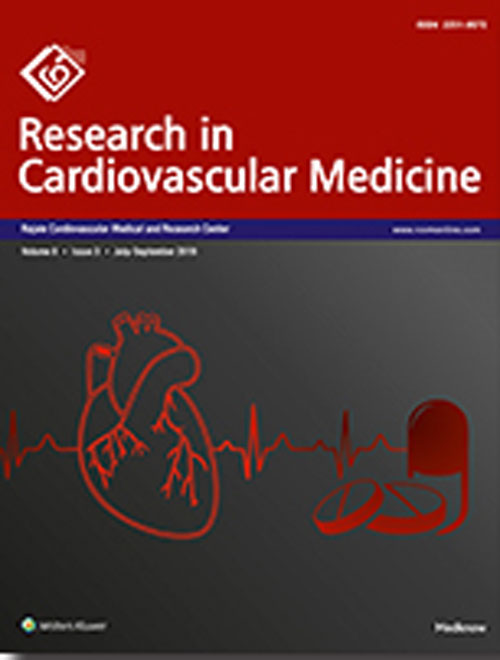فهرست مطالب

Research in Cardiovascular Medicine
Volume:8 Issue: 28, Jul-Sep 2019
- تاریخ انتشار: 1398/08/25
- تعداد عناوین: 5
-
-
Pages 69-75Introduction
Genetic load may indirectly influence on cardiovascular risk. This work aimed to analyze the influence of polymorphisms (APOA5 C56G-Ser19Trp, Prothrombin-G20210A, F5 Arg506Gln, MTHFR-C677T, LIPC-C-514T, LPA-I4300M, PPAR_ALPHA-L162V, APOA5-1131T > C, APOE-APOE2/3/4, and APOE-APOE2,3,4) in plasma triglyceride (TG) levels of patients ingesting plant sterols.
Materials and MethodsDouble-blind, crossover, controlled clinical trial was performed in 45 individuals (25 women). About 2.24 g sterols in milk and placebo milk were ingested daily during 3 weeks each, separated by a 2-week washout period. Blood draws and saliva genomic DNA was extracted.
ResultsAPOA5-C56G-Ser19Trp, MTHFR-C677T, and PPAR_ALPHA-L162V greatly benefit from sterols intake. APOA5-C56G-Ser19Trp GG homozygous carriers lowered their TGs more than CG heterozygote carriers (P = 0.003). TT homozygous carriers of gene LIPC C-514T experienced an increase of TGs.
ConclusionsFurther studies are needed to establish which genotype combinations is the most protective against hypertriglyceridemia.
Keywords: Cardiovascular disease, genetic, nutrigenomic, plant sterol, triglycerides -
Pages 76-78Background
Electromagnetic interference can cause damage to cardiac implantable electronic devices (CIEDs). The current guidelines recommend the interrogation of all pacemakers and defibrillators before and after surgery. The objective of the study was to evaluate the safety and outcomes of noncardiac surgeries in patients with CIEDs.
MethodsBetween January 2014 and January 2019, all patients with CIEDs who underwent noncardiac surgery were included. The patient’s baseline characteristics and data regarding their procedure and postsurgical complications and mortality were extracted from their medical records. The device analysis 6 months after the procedure was also seen.
ResultsOf the 54 patients, 16 had permanent pacemaker, 25 implantable cardioverter defibrillator, and 13 cardiac resynchronization therapy device. Most common indication for surgery was inguinal or abdominal hernia (n = 46); three patients underwent surgery for cholecystitis and five for other reasons. Supraventricular tachycardia was reported in one patient during surgery and in another one after surgery. Only one patient experienced intraoperative ventricular tachycardia. There was no device malfunction during and after surgery. During 6-month follow-up, 5.6% mortality rate was reported.
ConclusionsWith recommended device programming before surgery, noncardiac surgery is well tolerated in the majority of the patients with CIEDs without significant interference in the device function.
Keywords: Implantable cardiac devices, malfunction, noncardiac surgery, safety -
Pages 79-83Background
Chronic kidney disease (CKD) affects multiple organs and is an established risk factor for cardiovascular disease and mortality. Impaired systolic function of the left ventricle is common in adult CKD patients.
ObjectiveThe main objective of the study is to determine the prevalence of left ventricular systolic dysfunction (LVSD) in children with CKD and its association with age, stage of disease, and history of dialysis. Subjects and
MethodsThis was a comparative cross-sectional descriptive study. Twenty-one children with CKD aged 3–14 years and an equal number of age- and gender-matched apparently healthy controls were recruited. Outcome Measures: LVSD was considered present when ejection fraction (EF) <50%.
ResultsThe mean EF of 63.9% in the patients was not significantly lower than the 65.3% recorded in the controls, but LVSD was detected in 5 (24%) and none of the controls (Fisher’s exact; P = 0.001). Patients with LVSD were older than those with normal left ventricular systolic function, but this difference was not statistically significant (P = 0.067); however, they differed significantly with respect to the stage of CKD (P < 0.001). LVSD was more common in patients who were never dialyzed (P < 0.001).
ConclusionLVSD is more frequent in children with CKD compared with controls. Patients with LVSD were similar to those without it, with respect to age but had more advanced disease (CKD) and less likely to have ever been dialyzed.
Keywords: Children, chronic kidney disease, ejection fraction, left ventricular systolic dysfunction -
Pages 84-86
Anomalous origin of the left coronary artery from the pulmonary artery (ALCAPA) syndrome is a rare congenital anomaly occurring in 1 of 300,000 births. As it has high mortality rate during the 1st year of life, adult type is very rare. Arrhythmias, heart failure, myocardial infarction, and sudden cardiac death are common presentations of ALCAPA syndrome in adults. Here, we report a 28-year-old male with malignant ventricular arrhythmia and sudden cardiac death. ALCAPA syndrome was diagnosed by coronary angiography and echocardiography; finally, cardiac surgery was performed with a good result.
Keywords: Anomalous origin of the left coronary artery from the pulmonary artery, arrhythmia, cardiac surgery, congenital anomaly, heart failure, sudden cardiac death

